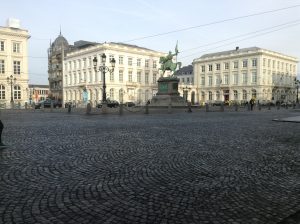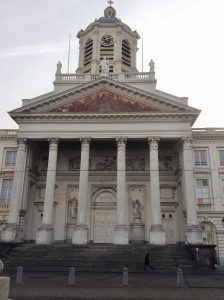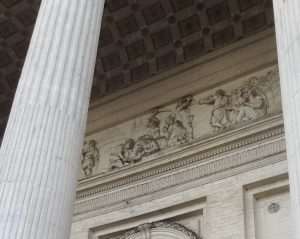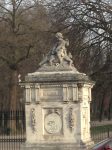I am quite fond of the hotel, Hotel Chambord. It’s comfortable, rather than elegant, but located close to the office in a nice area. I am living in a little room right at the top of the house with a beautiful view of Brussels. To get to the room, I take a little lift – the kind that’s made for one – to 6ème étage, walk past all the sixth-floor rooms, through a heavy door, up a final flight of stairs and through another heavy door. There are only four rooms on the floor. The light in the hallway is activated by motion censor because the hall is not used enough to justify keeping it on all the time. It feels like a tower-room from a centuries-past European children’s story.
On Saturday morning, I do a little work, then head down to breakfast. The breakfast room is on the first floor. It’s warm and cosy. Croissants, crispy French bread, ham, cheese, a little bacon and egg and good coffee. I linger over a second cup of coffee. Before I came, I was warned that Brussels would miserably cold at the end of January. Colleagues who had been here the previous week, when it snowed, were all commiseration. I panicked a little: my last northern winter was a good few years ago and I no longer own the kind of winter woollies I used then. It’s not that cold, in the end. A good coat, a pair of warm shoes, jeans, scarf and gloves and I was perfectly happy. I finish my coffee, fetch my coat and head off.
 Down the street, past the designer boutiques, the road opens through an archway into a cobbled square. Trams clang by every few minutes, with cars and buses passing around them. In the centre of the square stands a monument to the crusaders. Belgium seems to have a particularly thick skin when it comes to political correctness and/or sensitivity. They recently closed (to review the collection) an alarmingly racist museum celebrating the rape and pillage by King Leopold II of what is now the Democratic Republic of the Congo.
Down the street, past the designer boutiques, the road opens through an archway into a cobbled square. Trams clang by every few minutes, with cars and buses passing around them. In the centre of the square stands a monument to the crusaders. Belgium seems to have a particularly thick skin when it comes to political correctness and/or sensitivity. They recently closed (to review the collection) an alarmingly racist museum celebrating the rape and pillage by King Leopold II of what is now the Democratic Republic of the Congo.
All around the cobbled square stand stately old buildings. One is a church, with columns and a bell tower and statues, each with a musical instrument. Some of the frieze work seems rather violent but the statues carry musical instruments and the facade is stately and elegant. A reminder of the history of monarchy, a plaque commemorated coronation in 1831 of Leopold I, first king of the Belgians after independence in 1830.


 By the time I reach the gardens near the palace (just a block further), the cloud has burned off and the sun has begun to shine. When I return home, colleagues and friends who know Belgium are astonished to hear my tales of sunshine in Brussels. I think some of them think I’m making it up. Like the perfect spring day I spent in Paris, I guess sometimes you get lucky. The sun is just in time to light up a statue a-top the gates of the park: a child or a cherub standing over a recently hunted wild boar.
By the time I reach the gardens near the palace (just a block further), the cloud has burned off and the sun has begun to shine. When I return home, colleagues and friends who know Belgium are astonished to hear my tales of sunshine in Brussels. I think some of them think I’m making it up. Like the perfect spring day I spent in Paris, I guess sometimes you get lucky. The sun is just in time to light up a statue a-top the gates of the park: a child or a cherub standing over a recently hunted wild boar.
The palace itself is something out of a Georgette Heyer novel. Elegant lines set beyond shallow formal gardens, a million windows reflecting the sun, each with curtains pulled neatly back and in some glimpses of ornaments or furniture or bookcases. I could imagine, of an evening, carriages pulling up in the lamplight and letting down the steps for ladies in silks and muslins to trip up the steps to dinners and balls.

Not far away, and of all the museums I didn’t visit in Brussels the one I am determined to return for, is the museum of musical instruments. Thousands of musical instruments from many different eras are housed here. The museum offers an audio tour, to allow visitors to hear how each sounded. One reason, among many, to return.
Past the musical instrument museum, past the “La Pharmacie Anglaise – Cocktails and Curiosity” (which must be investigated further), I came across a fascinating clock built into the side of a building arching across a street (by the Mont des Arts). The sun glinting off metal clock hands. Choosing to “[keep] the first for another day” (yet know how way leads on to way…), I continued to the cathedral.
The gothic Cathedral of St Michael and St Gudula has a long history. A small chapel has probably existed on this spot since the 9th century, with a church being constructed in the 11th. The current gothic building was begun in 1226 and finally finished in 1519. The first Europeans settled in South Africa in 1652.
 I come upon the cathedral from the side, as I step out of a narrow street between towering buildings. The stonework is stunning, with arches and stone bridges between spires. I walk around the back, enjoying the statues in each niche and the sun catching a stained glass window. In the front, two huge towers loom over me as I idly listen to an Irish accent telling a tour group the history of the church. The church bells ring out over the city.
I come upon the cathedral from the side, as I step out of a narrow street between towering buildings. The stonework is stunning, with arches and stone bridges between spires. I walk around the back, enjoying the statues in each niche and the sun catching a stained glass window. In the front, two huge towers loom over me as I idly listen to an Irish accent telling a tour group the history of the church. The church bells ring out over the city.
Below the cathedral is a little park – just an island at an intersection really – complete with spindly winter trees and odd public artwork covered in graffiti. Graffiti seems to be as much of a feature of Brussels as a church on every corner. It’s the thing that scares but also attracts me – the hint of an undercurrent of dissatisfaction and desire for something better. This is not sanitised and perfectly controlled Amsterdam – this city has a mind of its own.
Towards Grand Place are streets lined with Frite stores, waffle houses and chocolate shops. Up one street, I wander around another pretty church – Madelaine chapel.
Nearby is the central station – Gare Centrale. I duck beneath an archway, drawn towards the station entrance by the sound of music. I stand for a moment, entranced. A man is playing a violin near the main doors. He smiles and gestures towards passers-by. His violin sings and soars. The music is beautiful. I often give a donation to people who share their music in public, who busk. Not normally in Euros. He greets me in French. His complement leaves me blushing into my red coat. I find a place further a little further off, struggling to drag myself away. Three times during the day, I return to Gare Centrale. Always just happening to pass by with the whims of my wanderings; always to listen to his music again. In years to come when I remember Brussels, as I’m haunted by memories of all my travels, my heart with long for that music.
 Further down the hill is the central square Grand Place, complete with unsymmetrical Town Hall. No really, the clock tower is not in the centre and the windows on the two sides are different. A group of women of Asian descent practice their dance for the evening’s Chinese New Year celebrations. Brussels is a very, sometimes uncomfortably for itself, mixed city. Across the square is the dark, looming shape of the museum which houses, I am told (presumably among other things), the clothes that are used to dress up the Manneken Pis statue on special holidays. The other buildings around the square glint with gilt in the sunshine.
Further down the hill is the central square Grand Place, complete with unsymmetrical Town Hall. No really, the clock tower is not in the centre and the windows on the two sides are different. A group of women of Asian descent practice their dance for the evening’s Chinese New Year celebrations. Brussels is a very, sometimes uncomfortably for itself, mixed city. Across the square is the dark, looming shape of the museum which houses, I am told (presumably among other things), the clothes that are used to dress up the Manneken Pis statue on special holidays. The other buildings around the square glint with gilt in the sunshine.
I wander a little more – past chappels and houses. Down a quite street, a tall building rises into the blue, blue sky, raising a weathervane in the shape of a ship in full sail. The sky is that deep winter blue that goes on forever. I don’t remember seeing that in places other than South Africa. It is one of the things I love so much about home – the winter sky. Today it is a gift from Brussels.